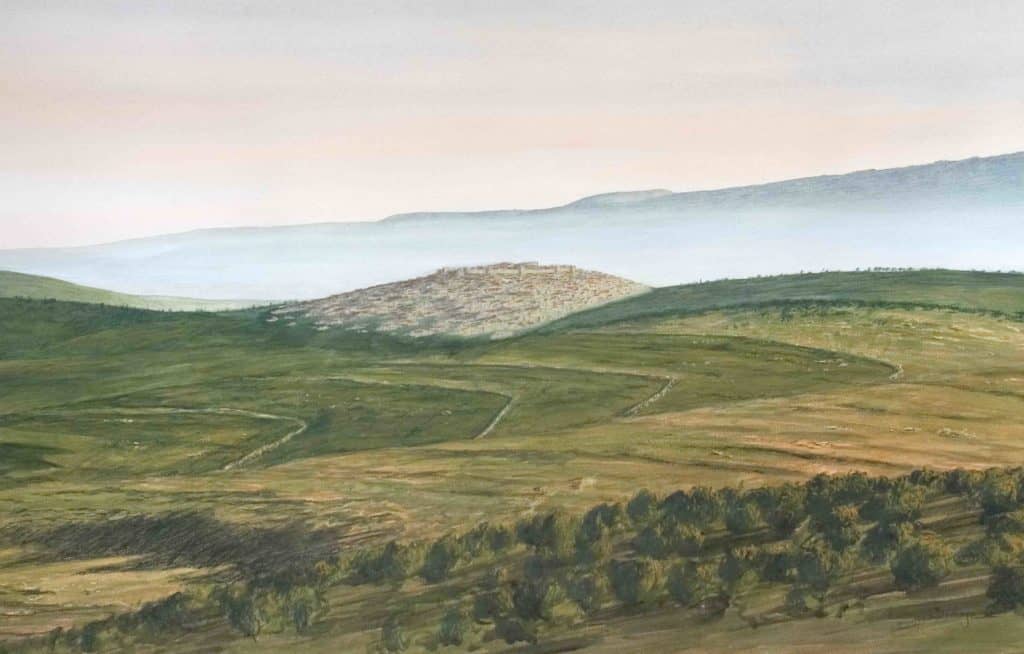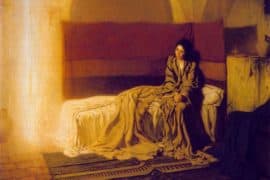When I think of Mary the mother of Jesus I think of the forgotten city of Sepphoris. According to tradition she was the firstborn daughter of an older couple named Joachim and Anna who lived there.[i] Few today have heard of Sepphoris. It is not mentioned in the New Testament. Until fairly recently it was not even included on those maps of the Holy Land found in the back of many Bibles. It had become a lost city to us—until very recently.
I first took my students to excavate at Sepphoris in the summer of 1996. We returned in 1999 and 2000 to participate in two more seasons of excavations. We joined one of the teams, led by Professor James Strange of the University of South Florida, who had begun digging there in 1983. After more than two decades of excavations by several teams of archaeologists not even one-tenth of the ancient Roman city has been exposed. Yet enough has been done to begin to offer us a glimpse of the splendor of the place in the time of Mary and her son Jesus.

When Jesus was growing up in Nazareth, Sepphoris was the dominant city of the entire region. Built on a hill rising 400 feet above the flat plain below, it is still visible from miles around. Jesus’ well-known saying that a “city set on a hill cannot be hid” surely came to him growing up in Nazareth and looking north at the gleaming city of Sepphoris four miles away. It could not be missed. Nazareth was hardly anything. Nestled in the hills, just to the southeast by a spring, the total population was probably not more than 200. It was one of dozens of small villages that dotted the plain around the huge and impressive capital city.
Today things are reversed. Nazareth is the largest Arab city in Israel with a population of over 60,000, half Christian, half Muslim. It literally fills the hills and valleys around its center with impressive suburbs and magnificent churches. Christian tours invariably include it as a major stop on their itinerary. Sepphoris is merely a bare hill dotted with ancient ruins in the distance. Every day at our excavations we would sit on the southern slopes of the ruins of Sepphoris and eat our lunch, gazing across the valley at the bustling city of Nazareth gleaming in the late morning sun. We tried to imagine how different things must have been in Jesus’ day, with the prominence of the two locations reversed. Though living in a small village, Jesus grew up just outside the urban capital of Galilee. The implications of this geographical fact are enormous as we seek to historically recapture hidden or forgotten aspects of the early life of Jesus.
When Mary was born, around the year 18 BC, the Romans occupied the northern area of Palestine called Galilee. Sepphoris was a Jewish city, but the Romans had made it the administrative center for the entire region. Herod the Great ruled the country. He had been an intimate friend of Antony and Cleopatra. The Roman general Octavian, later to reign as Caesar Augustus, confirmed him as “King of the Jews.” And yet Herod lacked the vital Davidic bloodline that would have entitled him to such a throne.[ii] Herod had a Jewish mother but an Idumean father. He was sensitive about his half-Jewish origins which many Jews considered a disqualification for legitimate rule over Israel. Out of jealousy and fear he ordered the public genealogical records of the leading Israelite families destroyed. He also married Mariamne, a princess of the priestly Hashmonean in a vain effort to placate Jewish opposition to his base origins. The Hashmonean line is the one that produced the Maccabees who had ruled the country for a century before the Romans invaded Palestine. In a fit of rage Herod later murdered her and their two sons. Josephus, the 1st century Jewish historian tells us that he went so far as to equip the desert fortress Masada as a place to flee should the population depose him and restore a ruler of David’s royal line.[iii] The Roman emperors Vespasian and Domitian would search out and execute members of the royal “house of David” family in the late decades of the 1st century.[iv] In those times power was one thing, but pedigree—particularly that of the native royal family—was quite another. And this matter of pedigree takes us right back to Nazareth.
In 4 BC, when Mary would have been about fourteen, Herod the Great died. Shortly after the death of this “king” a man known as “Judas the Galilean” broke into the royal palace at Sepphoris. After seizing all the arms that were stored there, he and his followers began to rampage throughout Galilee. Pockets of revolt and opposition to Rome broke out all over the country.[v] Josephus wrote that at that time “anyone might make himself king as the head of a band of rebels,” and he named several others who tried.[vi] The Romans reacted quickly and with overwhelming force. The Roman governor of Syria, the infamous Publius Quintilius Varus, led three legions from Syria to brutally crush opposition to Roman rule.[vii] Including auxiliary forces as many as 20,000 troops poured into the country from the north, burnt Sepphoris to the ground, and sent its inhabitants into slavery as punishment for their participation in the outbreaks. Varus rounded up rebels all over the country and crucified 2000 men who had participated in the revolt.[viii] The trauma that gripped Galilee must have been dreadful, with dying men nailed to crosses at intervals up and down the main roads or on hillsides visible to all who passed.
Following the revolt the Romans divided Palestine into three districts, each ruled by a son of Herod the Great. Archaelaus received Judea which was in the south and included the mountainous territory to the north called Samaria. Philip was given charge of the region east of the Jordan, around the Sea of Galilee. Herod Antipas received the territory of Galilee, north of Judea, as well as Perea that lay east of the Jordan River. This was the same Herod that later beheaded John the Baptizer and participated in the trial of Jesus. Herod chose to fortify and rebuild the city of Sepphoris, making it his palatial capital, and he did it in high Greco-Roman style. It occupied a strategic location overlooking the Bet Netofa valley with major roads intersecting. Though it remained a Jewish city it had a 4000-seat theater as impressive as the one his father had built at Caesarea on the Mediterranean coast, colonnaded streets and markets, elaborate civic buildings, an elaborate water system, and public baths. Josephus, who was eyewitness to its splendor, writes that Sepphoris became the “ornament of all Galilee.”[ix] But as Herod Antipas consolidated his hold over his bequeathed territories, his legitimacy to the throne was suspect. Who was the rightful King of Israel?
Sometime before the conflagration of Sepphoris Mary and her family moved to the little village of Nazareth, just four miles southeast, practically still in the shadow of Sepphoris. We have no record of what happened to her parents, Joachim and Anna, or whether they were still alive at the time, but we do know what became of their daughter.[x]
At the time of the revolt and brutal suppression, Mary, at the age of fourteen or fifteen was already considered a woman and was pledged in marriage to a local artisan named Joseph. It was there in Nazareth at this time that she had her own troubles—she got pregnant before the marriage and Joseph was not the father. Luke says that when the couple went to Bethlehem for the birth of Jesus Mary was still his betrothed (Luke 2:5). The Greek word he uses is very clear.[xi] It means they were still only engaged yet she was ready to deliver the child. After the birth of her child in Bethlehem the couple returned to Nazareth, right in the aftermath of the disaster, with the smoke of Sepphoris scarcely cleared.[xii]
When you understand the history of Sepphoris a whole new set of images is added to the “Christmas story”: crucified corpses rotting on crosses, the nearby capital city in flames, and fellow citizens either killed or exiled into slavery. The future of this family and the child that they carried was hardly certain.
[i] Mary’s parents, Joachim and Anna, are not named in the New Testament. Our earliest source is the 2nd century AD Gospel called The Protevangelium of James. A reliable 3rd century Greek copy, the Bodmer papyrus, was recently discovered. Joachim and Anna became popular figures in Catholic lore and their story was a favorite theme of Renaissance artists. Churches were dedicated to St. Anne as early as the 5th century and are common throughout the world today. The tradition that Mary was born in Sepphoris is much later, and less reliable, first mentioned by the “Piacenza Pilgrim” in 570 AD. He reports being shown the house of Mary. A Crusader church was built to commemorate the site, but there is some evidence of Byzantine remains on the grounds including a 3rdcentury mosaic. Today the “Sisters of St. Anne” maintain a convent there and maintain the tradition of Mary’s family.
[ii] Josephus, Jewish War 1. 386-397 and Jewish Antiquities 15. 194-201.
[iii] Josephus, Jewish War 7. 300. The destruction of the genealogies is reported by Julius Africanus (Eusebius, Church History 1. 7. 11-13.)
[iv] See Eusebius, Church History 3. 12 and 19. These texts will be analyzed extensively in subsequent chapters.
[v] Some have put the death of Herod slightly later but 4 BC is the most commonly accepted date.
[vi] Josephus, Jewish Antiquities 17. 271-285. Translations from Josephus are by J. St. J. Thackerary in the Loeb Classical Library edition.
[vii] Varus’s rule in Syria was characterized by cruelty and arrogance toward the local population. This is the same Varus responsible for the devastating Roman defeat in the Teutoburger Forest, east of the Rhine, in 9 AD by the German Arminius, changing the course of history. The Romans lost three legions in what became known as the “Varus Disaster” (Clades Variana). Varus was married to the grand-niece of the emperor Augustus and was well connected in aristocratic Roman circles. According to the Roman historian Seutonius when Augustus heard the news of the defeat he knocked his head against the door-post crying out “O Quintilius Varus! Give me back my legions!”
[viii] Josephus, Jewish Antiquities 17: 285-298 and Jewish War 2. 66-75.
[ix] Josephus, Jewish Antiquities 18. 27. The Greek word he uses, proschema could be translated in this context as “showplace.”
[x] In Jerusalem, just outside the Garden of Gethsemane in the Kidron Valley, there is the “Church of the Tomb of the Virgin,” sometimes called the “Church of the Assumption.” Queen Helena, mother of the emperor Constantine, built it in 326 AD. It claims to have the graves of Mary, Joseph, and Mary’s parents Joachim and Anna. We have no independent evidence the deaths of Joseph and Mary’s parents in Jerusalem.
[xi] The Greek verb mnesteuo means one is legally pledged to be married. It is the same verb used of Mary in Luke 1:27 and Matthew 1:18. In Jewish tradition “engagement” is a type of preliminary “marriage,” but without full consummation, and sexual unfaithfulness is regarded as adultery (Sanhedrin 57b).
[xii] This is according to Luke 1:26. Apparently Matthew is unaware of this tradition. He does say that the couple eventually settled in Nazareth, but only after the birth of Jesus (Matt 2: 23).









Comments are closed.